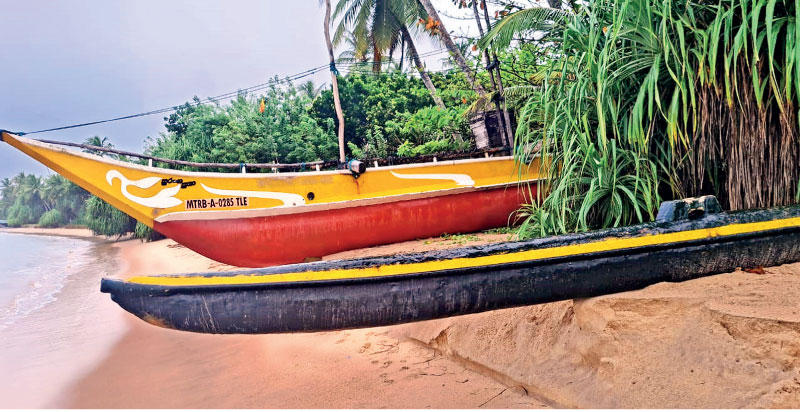Tuesday Jan 13, 2026
Tuesday Jan 13, 2026
Thursday, 28 October 2021 00:01 - - {{hitsCtrl.values.hits}}

Mawella Bay, Tangalle
|
The sea unusually encroaching on the mangroves in Mawella Bay
|
Most often we don’t succeed or progress because there is a mismatch in our actions i.e. in what we do and the results we expect. In some ways, it could be said that we continue to grapple with paradoxes, because we keep doing things that are counterproductive and then ask ourselves why we are not successful and progressing!
If we were to look at examples of what I am talking about, there are many similar situations that are going on around us that could be pointed out, and the list may seem endless. But for the sake of this article I would like to highlight just one such example. I am a naturalist myself, albeit a student rather than an expert. As a person who travels the island to observe our wildlife in its natural habitat, what I find is that we are not doing enough in terms of real conservation. There is a lot more that is required to be done for the wellbeing of our island’s natural resources or to put it more simply, for protecting our environment.
The physical appearance of our island, its ambiance, splendour and the magical experience it can provide a visitor are all unique. Left untouched, it can be a boon to us all in the form of an industry like tourism. Tourism and the environment are interconnected and the proper handling of it is very important. But, we continue to take actions that cause harm to our environment and impede the development of tourism.
 Beach tourism not made priority
Beach tourism not made priority
There are many types of tourism and, for us islanders, beach tourism stands at the top. With approximately 1,600 km of beach wrapped around the island, beach tourism taking priority is inevitable and something that should be taken advantage of. Be that as it may, in the last forty years or so, our country’s development plans do not seem to take this important factor into account. Therefore, our actions in this vital area of beach tourism don’t support the success we expect, because we are not doing much to preserve one of our primary natural resources — our beaches.
The best example of this is what happened at Unawatuna. Once named by the Discovery Channel as ‘The Best Beach in the World,’ it has been laid to waste today, due to a badly planned breakwater, built nearly a kilometre into the ocean. This has disturbed the natural balance of the ecosystem, washing away sand from one half of the beach, and depositing it on the other. The picturesque beach of this major tourist attraction of the south is now almost entirely claimed by the ocean. Three-fourths of the Unawatuna coast is destroyed by giant waves that crash onto the sandy shores hour by hour and the once thriving tourism business in that area would never be the same.
Coastal protective hard structure counterproductive
Although building hard structures on the coast is probably done with all good intentions, they seem to be counterproductive because adjacent areas on the coast get affected. In fact they seem to act as a catalyst for destruction, in the form of erosion, unpredictable waves and disastrous change in ocean currents all going towards nullifying beach tourism.
However, the many reports written on the subject and presented to relevant authorities seem to be falling on deaf ears.
A report on ‘Coastal Area Management in Sri Lanka’ prepared by Kem Lowry of the University of Hawaii and H.J.M. Wickremeratne of the Coast Conservation Dept. in 1988, has a section on ‘Ill-designed Coastal Erosion Protection Structures’ which refers to several reactive measures taken by the Coast Conservation Department (CCD). These were probably done under public pressure to prevent erosion, but they have without a doubt proved disastrous. According to Lowry and Wickremeratne, some of the structures were built without any scientific understanding of the local coastal dynamics, resulting in the ‘solution’ to prevent erosion in one area, causing considerable erosion to occur elsewhere.
Giving an example of such ill designed coastal works, the paper refers to a long groyne construction built to stabilise the outlet of the Panadura river. The objective of the construction was to ensure that the river mouth remained open as an outlet to the Bolgoda Lake and to prevent the periodic flooding of adjacent paddy land. A secondary objective was to allow fishing boats access for mooring. Although these objectives were achieved, the groyne caused serious erosion to the north of the river, blocking the littoral supply of sand to the entire coastline from Egodauyane to Ratmalana. Numerous houses have been washed away, and the beaches of Egodauyana and Lunawa have disappeared. The main coastal railway in this area continues to exist only because of major revetments.
The paper also says “an even more dramatic example occurred when the construction of a breakwater was begun at Wellamankara in the north of Negombo, as a part of a project to build a fishing harbour along this straight portion of coast. The breakwater resulted in such severe erosion that an entire fishing village to the north of the breakwater was eventually washed away, further erosion was prevented only by removing the breakwater at a cost exceeding that of the original construction.”
Potential disaster at Mawella Bay
Despite these disasters, the construction of hard structures continues. Over the past year decisions have been made by state agencies to construct a 300 metres long stone anchorage and two offshore breakwaters at Mawella Bay, another one of our country’s beautiful untouched beaches. This decision is currently being challenged by the locals who believe it would be harmful to their environment, because once again there is no evidence of any proper scientific study done on the proposed construction.
A report by Professor Charitha Pattiaratchi, Professor of Coastal Oceanography at the University of Western Australia says the construction of these two 60m offshore breakwaters is not recommended, because they will be located in a region with high wave and current activity. The region for the proposed breakwaters is a highly complex one in terms of hydrodynamics and sand transport. The breakwaters once built will retain sand in the lee, thus interrupting the alongshore transport of sand. As the sand retained would be from regions along the ~1.5 km length of beach, there is a strong probability of extreme erosion occurring in other regions of the now beautiful Bay.
People’s influence on the environment a leading factor in coastal erosion
A recent report published by the Asian Development Bank Institute (ADBI) in March 2021 titled ‘Are coastal protective hard structures still applicable with respect to shoreline changes in Sri Lanka?’ also pointed to the dangers of these man-made structures in trying to prevent erosion. It said that the application of hard structures to mitigate the effect of coastal erosion has increased within the past 15 years.
The report refers to coastal protective hard structures as ‘anthropogenic activities.’ Anthropogenic means relating to, or resulting from the influence of human beings on nature. The report concluded that ‘the part of the study area experiencing coastal erosion due to anthropogenic activities may face more drastic changes in its shoreline and environment than other areas in the Western and North-Western regions of Sri Lanka. Therefore, anthropogenic activities are the leading factor in coastal erosion in the respective study area rather than natural scenarios such as a sea-level rise, climatic changes, and natural disaster conditions.’
The report also highlights that the application of hard structures is the solution that is least able to control coastal erosion in a large area because applying hard structure is good for the site but not very helpful for other adjacent areas. Therefore, as long as humans introduce no alterations, the environment will remain under its natural conditions. If the shoreline is changing naturally, as humans, we have to adjust rather than alter it.
Hard structures a problem rather than a solution
With all this evidence pointing towards breakwaters, groynes, revetments (artificial walls) and coves causing more damage than solution, it is necessary for us to look more carefully at these manmade coastal constructions.
I believe the cost of building these structures have to be carefully evaluated. The breakwater that was built on the southern side of the Colombo harbour for the extension of the port was no doubt meaningful from a business sense. Especially in terms of the development of our capabilities in handling transhipment which has had a massive positive economic impact on Sri Lanka. However, constructing breakwaters at every nook and cranny on our coast without proper scientific research and understanding is counterproductive. The latest problem faced by residents and investors in the Mawella Bay area is typical of this malady. The local residents of the Mawella Bay area recently found the sea unusually encroaching on the mangroves, causing great distress to them. They attribute the cause of this to the building of an anchorage in the bay.
To put it in context, Mawella Bay is two kilometres long, pristine, and well suited for high end tourism. This is one of the few beaches on the southern coast of the island that is calm, serene and remains swimmable all year round. For these reasons the bay has been benchmarked as an area for investment in creating a unique boutique tourism destination. Ad hoc plans without any scientific basis have been utilised to put up stone structures to disturb a sustainable environment that has survived centuries of changes in tides and currents to make it a beautiful, safe bay.
Someone needs to make the decision on how development work is done in the country, in a manner that is sustainable and of value to everyone. But who will make that call?

Signs of the Mawella beach eroding
(The writer is a wildlife and underwater photographer and conservationist.)